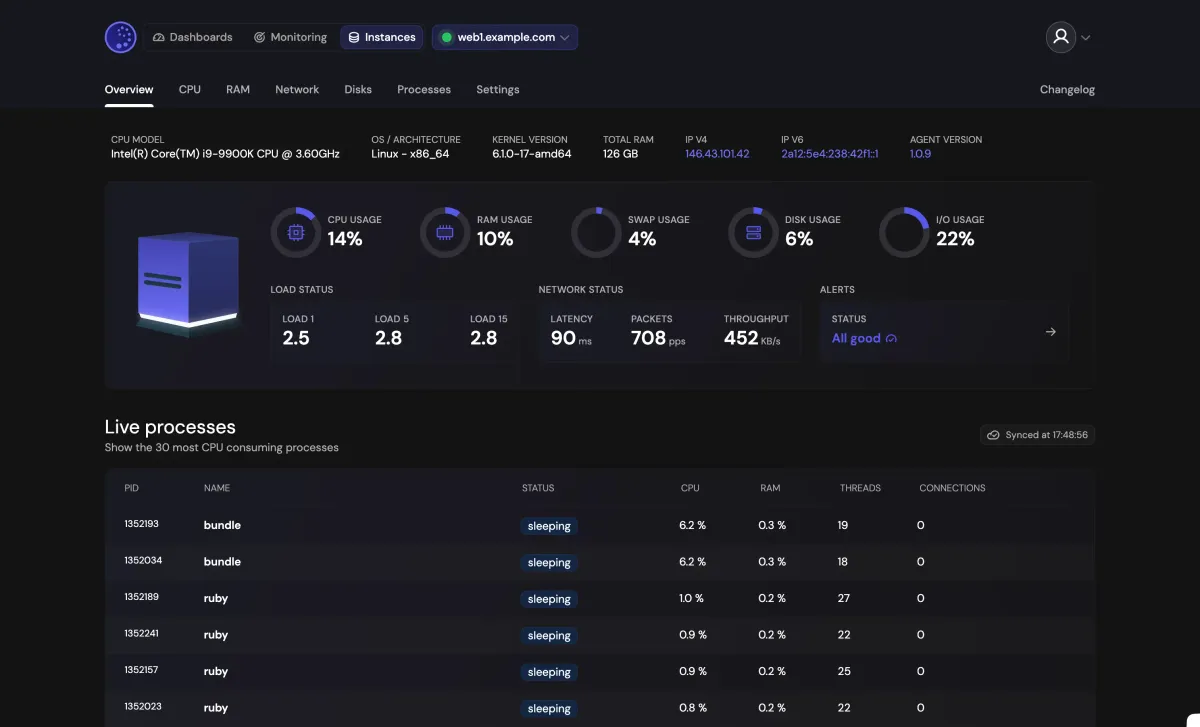Server Performance Monitoring: Key Metrics and how to achieve Five‑Nines Uptime

Imagine losing potential customers because your website slowed to a crawl—or worse, went offline. Studies show that a site loading in 1 second can convert up to 5× better than one that loads in 10 seconds. Downtime is even costlier: 25 % of enterprises report losing $300 k–$400 k per hour of outage (source).
These realities make server performance monitoring essential. By continuously tracking server health and performance, teams can spot issues early, maintain speed, and maximize uptime.
What Is Server Performance Monitoring?
Server performance monitoring is the continuous practice of observing a server’s vital signs—CPU, memory, disk, network, application response time, and more—in real time. A monitoring agent collects these metrics (on‑prem or in the cloud) and alerts you to anomalies so you can act before users notice a problem.
Why Is Server Performance Monitoring Important?
- Ensure Maximum Uptime – Achieving 99.999 % (five‑nines) uptime allows only ~5 minutes of downtime per year.
- Prevent Costly Outages – Early warnings (overheating, memory exhaustion, disk failures) let you fix issues before they cascade.
- Protect User Experience & SEO – Slow servers hurt conversions and rankings; tracking response time reveals slowness fast.
- Capacity Planning – Trend data reveals when to scale resources or optimize code.
- Compliance & SLAs – Detailed logs back up uptime commitments and satisfy auditors.
Core Server Performance Metrics Explained
CPU Utilization
CPU utilization measures how much processing capacity is in use (expressed as a percentage). Brief spikes are normal, but sustained high usage (> 85 %) indicates the server is overloaded or an application is CPU‑bound. Continuous monitoring helps you decide when to optimize code, distribute workload, or scale to more cores.
Memory Usage
Memory usage tracks the portion of RAM consumed by the OS and running processes. When available memory falls too low, the OS swaps data to disk, dramatically slowing performance or causing crashes. Monitoring reveals memory leaks, runaway processes, and when it’s time to add RAM or tune applications.
Disk Utilization & I/O
Disk utilization shows how much storage space is consumed, while disk I/O (input/output) measures read/write operations. A nearly full disk can halt writes, and sustained high I/O can throttle database or file workloads. Keeping an eye on these metrics prevents storage bottlenecks and uncovers opportunities—like adding indices or moving to faster SSDs.
Network Throughput & Latency
Throughput is the volume of data moving through network interfaces; latency is the time it takes packets to travel between endpoints. Saturated bandwidth or high latency leads to slow page loads, timeouts, and frustrated users. Monitoring helps you pinpoint congested links, misconfigured firewalls, or external ISP issues.
Server Uptime (Availability)
Uptime tracks how long a server remains reachable. Even a perfectly tuned machine is worthless if it’s offline. Health checks (e.g., ICMP pings, HTTP probes) from multiple geographic regions verify global availability and alert you the moment downtime begins.
Response Time
Response time measures how quickly the server completes a request—such as an HTTP call or database query. Rising response times often precede full outages: they’re an early signal of resource saturation, code regressions, or third‑party API delays. Keeping this metric low is critical for user satisfaction and SEO.
Error Rates & Logs
Error rate is the percentage of failed or erroneous requests (e.g., HTTP 5xx, database timeouts). Log monitoring surfaces critical exceptions or stack traces that don’t always show up in resource metrics. A sudden spike in errors warns you of application bugs, failed deployments, or misconfigurations.
Choosing a Server Monitoring Tool
Traditional vs. Modern – Self‑hosted tools like Nagios are powerful but complex. Cloud platforms such as Splunk or Datadog are feature‑rich yet pricey. Fivenines.io delivers enterprise‑grade monitoring without the enterprise‑grade pain.
- Easy onboarding – A lightweight, open‑source agent and a clean UI get you monitoring in minutes.
- Comprehensive metrics – CPU, memory, disk, network, cron jobs, ports, and custom checks—all visible in customizable dashboards.
- Smart alerting – Fine‑grained thresholds, escalations, and integrations with Slack, Teams, and email.
- Transparent pricing – A generous free tier and pay‑as‑you‑grow plans—often 50 % less than legacy vendors.

Best Practices for Effective Server Monitoring
- Monitor proactively, not reactively – Test alerts with simulated failures.
- Set clear thresholds and avoid alert fatigue – Tune warnings vs. critical alerts.
- Cover every critical component – Include OS, application, and external dependencies.
- Review trends regularly – Weekly trend reviews spot gradual degradation.
- Iterate – Update dashboards and thresholds as your stack evolves.
Conclusion: Aim for Five‑Nines Uptime
Server performance monitoring is indispensable for delivering fast, reliable digital experiences. With a modern, affordable platform like Fivenines, teams of any size can achieve deep observability, lightning‑fast issue resolution, and 99.999 % reliability—without blowing the budget.
Ready to see for yourself?
➡️ Try Fivenines for free and start monitoring in minutes!




